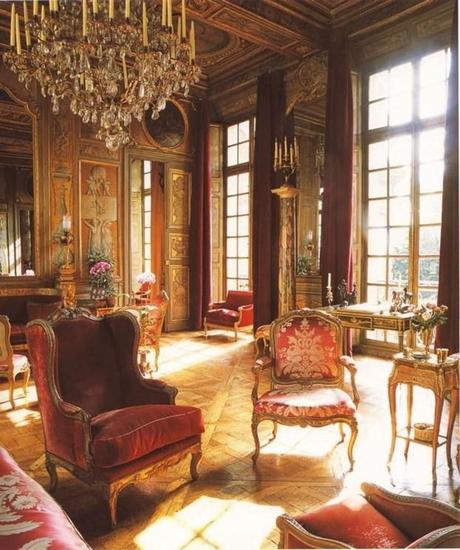The Hotel Lambert on the Île de Saint-Louis (river island of the Seine in central Paris) opposite the Île de la Cité. This Palace is one of the most beautiful of the many in the city of Paris (the so-called private hotels). The address is: Rue Saint-Louis en l'Île, 2.
The Hotel Lambert in Paris has been declared a World Heritage Site by UNESCO since 1991. The Hôtel de Lauzun, owned by the city of Paris since 1928 and with which the Hôtel Lambert forms a coherent architectural ensemble, also belongs to the Heritage of the Humanity.
As Hôtels particulier (private hotels), they represent exemplary Parisian architecture and cultural heritage of the 17th and 18th centuries. Notre-Dame de Paris Cathedral and the Sainte-Chapelle, both masterpieces of Gothic architecture, are among the most outstanding buildings on the Seine Islands.
The palace was built between 1640 and 1644 by Louis Le Vau (1), one of the most famous French architects of his time. He was the builder of the Palais Vaux-le-Vicomte southeast of Paris, who also played a key role in the construction of the Palace of Versailles.
The builder was initially Jean-Baptiste Lambert and, after his death, his brother Nicolas Lambert de Thorigny, president of the Chambre des comptes ("Royal Chamber of Accounts"). This person was one of the richest men in France. Lambert de Thorigny was fined one million pounds in the wake of the 1661 trial against King Louis XIV's ( 6) finance minister and owner of Vaux-le-Vicomte, Nicolas Fouquet ( 3).
The artists Charles Le Brun ( 2) and Eustache Le Sueur participated in the expansion of the Hôtel Lambert. The façade, rotunda and garden of Le Vau, together with the Hercules Gallery, a work by Le Bruns that points towards the Hall of Mirrors in Versailles (). This forms an ensemble that constitutes one of the most splendid urban representative buildings of the seventeenth century in Paris.
In 1732, the descendants of Lambert de Thorigny sold the palace to the financier Claude Dupin (1686-1769), whose second wife, Madeleine Fontaine, had a salon there.
Afterwards the Hôtel Lambert changed hands several times. For a time it belonged to Jean-Pierre Bachasson de Montalivet, Napoleon's Minister of the Interior, and was finally acquired in May 1842 by the Czartoryski family of Polish magnates, who bought the city of Paris at auction. The new owners immediately began renovating the Hôtel Lambert, which in the following decades became the center of political life for Polish emigrants.
In 1975, the Czartoryskis sold the property to banker Guy de Rothschild, who in 2007 sold it to Hamad bin Chalifa Al Thani, the Emir of Qatar, for about € 60 million. The sale sparked a violent legal dispute, which could only be resolved through the intervention of the Ministry of Culture and the Paris city administration. The conversion to a luxury residence included plans for an underground parking garage, which was eventually abandoned.
The building was to be renovated in 2013 for 50 million euros. During the renovation works, a fire broke out in the roof structure on the night of July 9-10, 2013, which quickly spread to the entire building. The roof structure was completely burned, the Minister of Culture, Aurélie Filippetti, announced that part of the damage was irreversible, such as the destruction of an artistically decorated bathroom by the painter Eustache Le Sueur. The whole ceiling collapsed on him. There was also damage to the particularly valuable frescoes by the painter Charles Le Brun, the so-called Gallery of Hercules.
After the failed uprising in Poland, in November 1830/1831, a part of the civil and military leadership of the rebels emigrated from Poland to Western Europe. They settled mainly in the city of Paris.

The head of the emigration was Prince Adam Jerzy Czartoryski, supported by his younger brother, Prince Konstanty Adam Czartoryski, the military leader of the November uprising. Its headquarters was the Hôtel Lambert, the Parisian home of the Czartoryski family, which also gave its name to the political option dominated by the Czartoryski, the liberal-aristocratic camp within emigration.
The policy of the " Hôtel Lambert" was aimed at restoring Poland as a constitutional monarchy in accordance with the provisions of the Polish constitution of May 3, 1791. Prince Adam Jerzy was the successor to the last King of Poland, Stanislaus II August Poniatowski, who abdicated in 1795. Furthermore, the "Hôtel Lambert" came out in favor of an agrarian reform based on the Prussian model. This reform would have meant the complete abolition of serfdom for the Polish peasants.
Intense diplomatic efforts were carried out in France and Great Britain and the struggle for the independence of the Balkan peoples was supported. A doctrine was adopted that only a European war could restore the independence of Poland as a state. This doctrine turned out to be correct, but it did not become apparent until 1918, after the First World War.
The cultural leadership role of the Hotel Lambert during the 19th century in the life of Polish émigrés was very important.
A whole series of political and historical emigration magazines were published, two schools for Polish boys and girls were created in Paris to prepare for university studies in France. Today it is housed in the Hotel Lambert in Paris, the Bibliothèque polonaise de Paris (Polish Library of Paris).
The Hôtel Lambert became a center of social life in the French capital, and regularly held costume balls were very popular. In addition to the greats of Polish emigration such as Frédéric Chopin, Zygmunt Krasiński, Michał Czajkowski and Adam Mickiewicz, there were artists and writers such as Alphonse de Lamartine, George Sand, Honoré de Balzac, Hector Berlioz, Franz Liszt and Eugène Delacroix. regular guests of the royal family.
The novel Paula Monti ou L'Hôtel Lambert (1842) by Eugène Sue gives an idea of that time. The famous art collection of the Prince's House was also housed here until 1876, after which it returned to Poland, where it can still be seen in the Krakow Czartoryski Museum to this day.
After the death of Prince Jerzy Adam in 1861, his son Władysław Czartoryski continued his father's work.
References European Palaces Decor
(1) Louis Le Vau: French architect (Paris, 1612-1670). He served as royal architect in the court of Louis XIV. See More National Library of France
(2) - Charles Le Brun : French painter (Paris, 1619-1690), whose classicism would make him one of the most prestigious artists of the court of Louis XIV.
(3) Nicolas Fouquet, marquis de Belle-Île, vicomte de Melun et Vaux (23 February 1615 - 23 March 1680) was the Superintendent of Finances in France from 1653 until 1661 under King Louis XIV. See More
(4) Jean-Baptiste Colbert: French statesman and economist (Reims, 1619 - Paris, 1683) implements mercantilist ideas from his position as general supervisor of Finance of Louis XIV. See More Library of Congress
The Hall of Mirrors Official Site - Palace of Versailles - France
died of gangrene on September 1, 1715, just four days short of his 77th birthday See More

